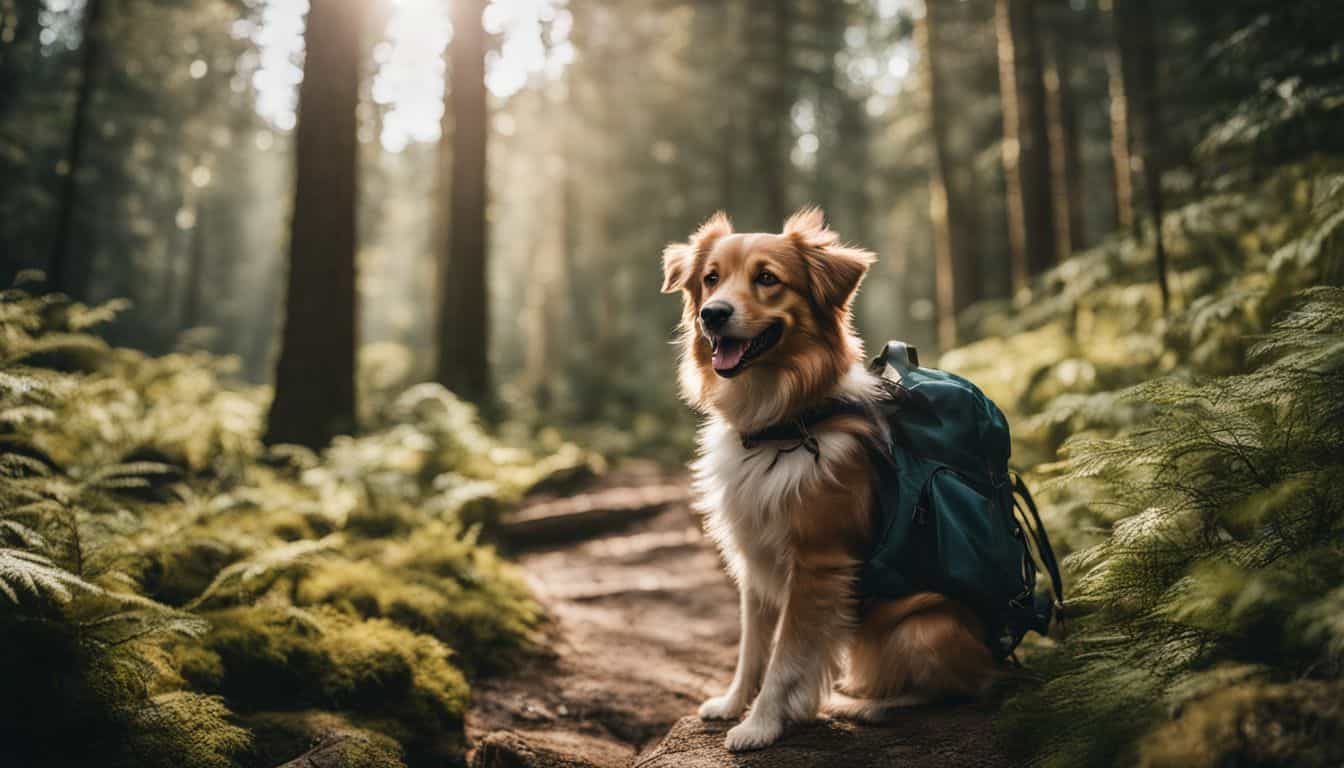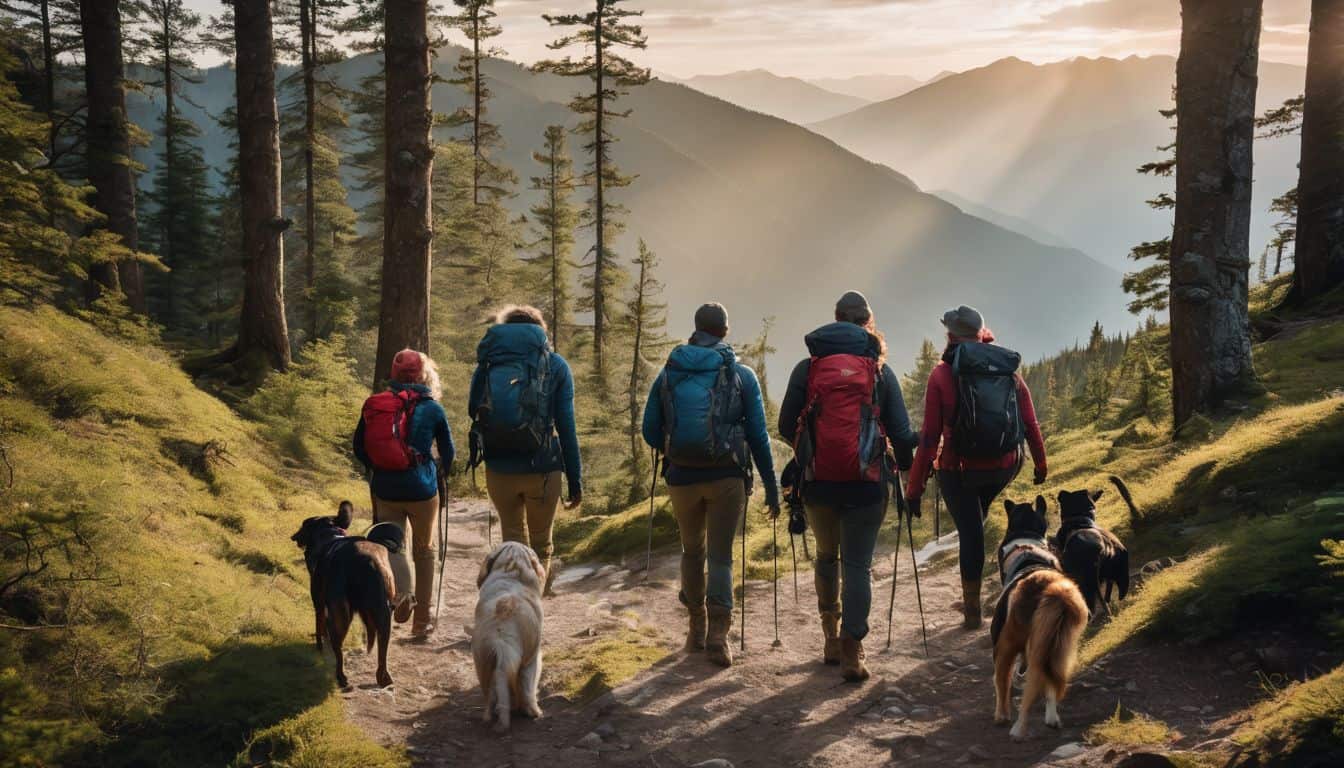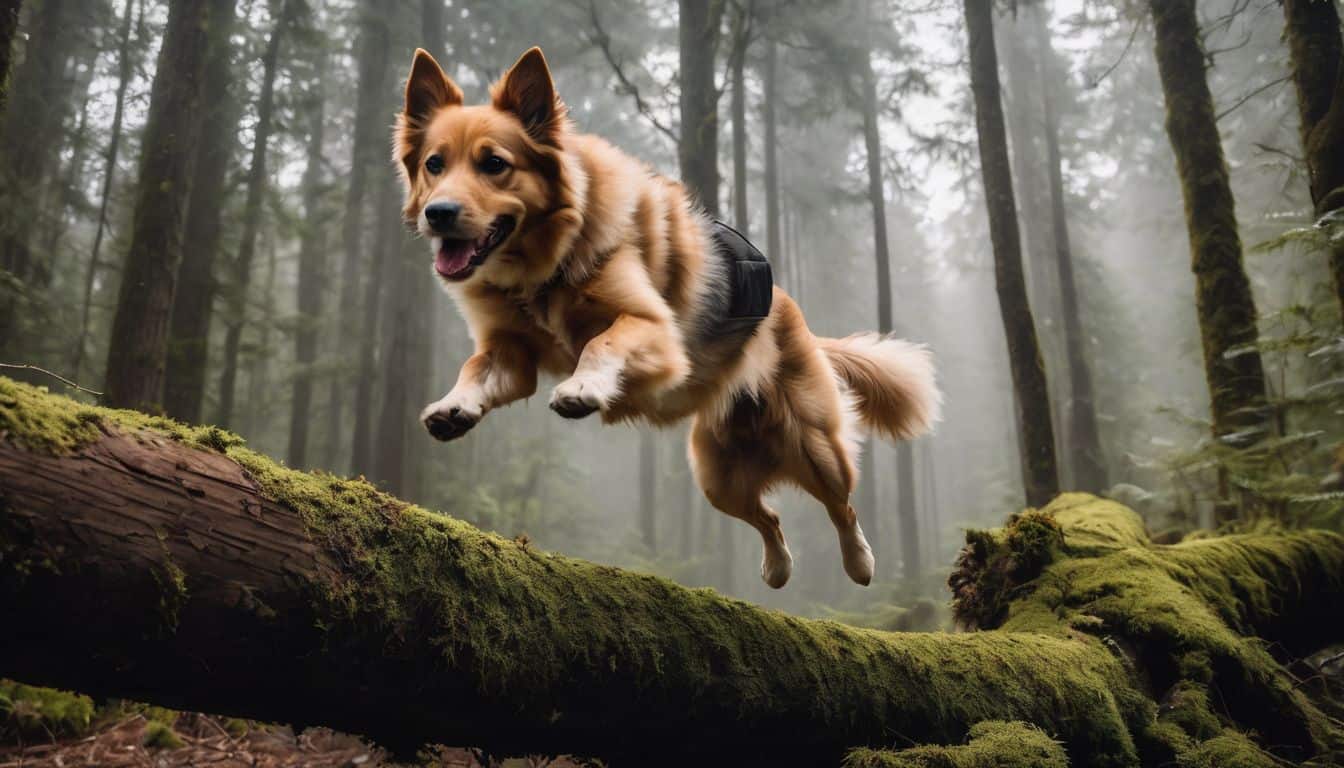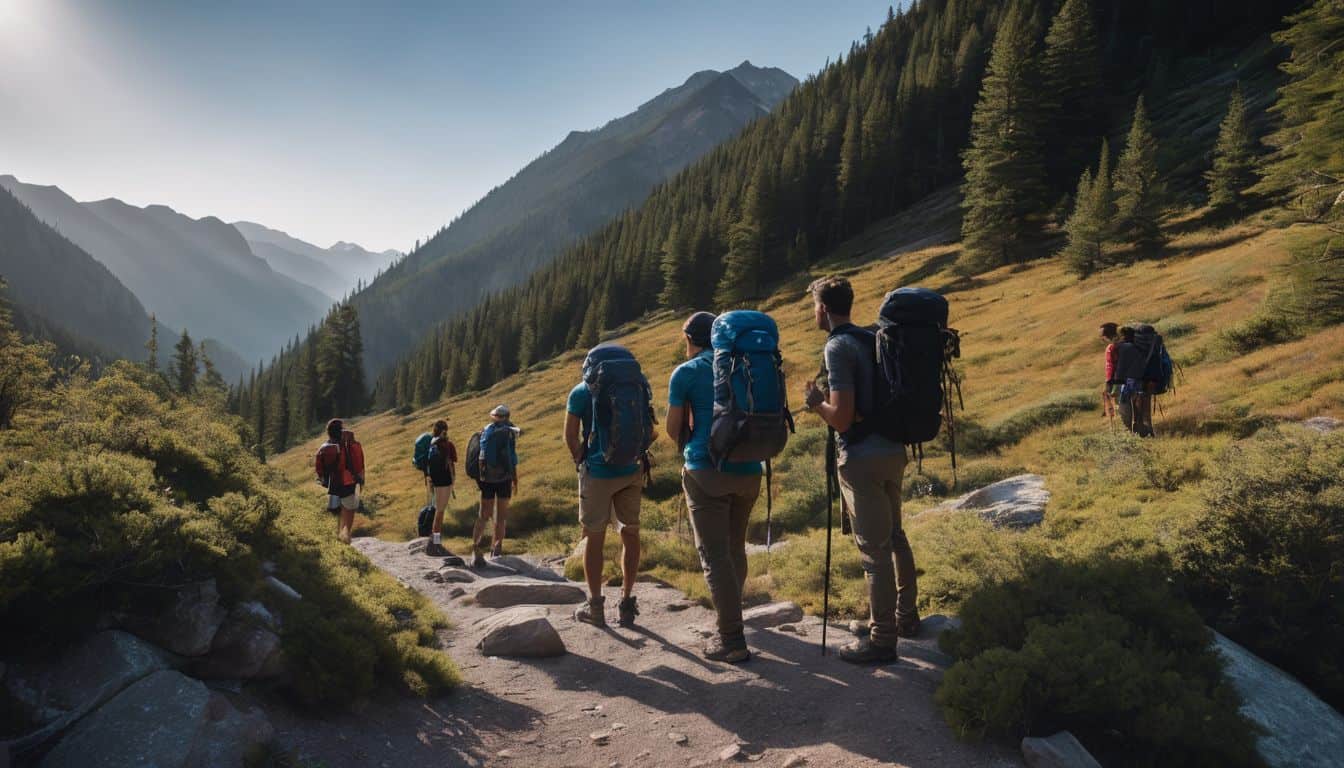Venturing on a hike with your best four-legged buddy can be quite the puzzle, isn’t it? Just know you’re not alone – after all, around 1 in 3 dog owners take their pup along for outdoor escapades like hiking.
I’ve spent much time planning out fun and safe ways to incorporate my own furry pal into these adventures. Therefore, rest assured that this article is brimming with practical nuggets of wisdom from personal experiences and extensive research.
So let’s gear up and prepare to take those ordinary hikes to extraordinary new heights that will make tails – and humans – absolutely ecstatic!
Key Takeaways
- Take your dog to the vet before hiking to ensure they are healthy and able to handle the adventure.
- Train your dog with obedience commands like “stop,” “come,” and “stay” for a safe hike.
- Gear up with essential items like a leash, collar or harness, backpack, ID tags, reflective gear, and comfortable clothing for your dog’s comfort and safety on the trail.
- Obey leash laws, clean up after your dog, and be courteous to other hikers by following trail etiquette for a respectful hiking experience.
- Bring necessary supplies including water, treats/food, favorite toy, pet insect repellent that is safe for dogs specifically designed for outdoor use.
- Pack sunscreen in addition to insect repellent specifically formulated for dogs to protect both you and your furry friend from the sun’s harmful rays.
- Include a first aid kit containing essentials such as bandages,
Preparing Your Dog for a Hike
To prepare your dog for a hike, start by taking them to the vet for a check-up and ensure they are in good health.
Start with a vet visit
Going to the vet first is a must. This trip helps me know if my dog can handle a hike. The vet checks my pet’s health and fitness. If there are any hidden health problems, the vet will find them.
This way I make sure my dog can enjoy the hike without getting hurt or sick. It feels good knowing that we’re set for success on our hiking adventure after this checkup!
Get your dog in shape
First, your dog must be fit for the hike. Walk with your dog often. It helps keep their weight in check and builds good health. Always make sure your dog is up for a big walk before setting off on one.
It’s also good to test your dog’s energy over time during walks. Keep an eye out if they tire too fast or are short of breath. Start slow if hiking is new for them by picking small trails first, then harder ones later on.
This helps build their fitness level and makes longer hikes easy down the road.
Obedience training
Obedience training is key for a good hike with your dog. This kind of training makes sure your dog listens to you. Voice command drills can help with this. They make your dog better at obeying while on the trail.
You need to be steady in how you train your pet. There are three main commands to teach: “stop”, “come”, and “stay”. These keep both you and your pooch safe during the adventure. Trail-specific skills also help a lot! With time and practice, hiking becomes an exciting, worry-free experience for both of you!
Proper gear (harness, leash, backpack, ID tags, etc.)
Having the right gear is essential for a successful hike with your dog. Here are some important items to consider:
- Collar or harness: A collar or harness is not only necessary for attaching a leash, but it also helps to identify your dog as a pet during the hike.
- Leash: A sturdy leash is important to keep your dog under control, especially in wilderness areas where there may be wildlife or other potential dangers.
- Backpack: Consider getting a backpack for your dog so they can carry their own supplies like water and food. This can help lighten your load and make the hike more enjoyable for both of you.
- Identification tags: Make sure your dog has updated identification tags with important information in case they get lost during the hike.
- Reflective gear: If you plan on hiking during low light conditions, such as early morning or late evening, reflective gear like a jacket, collar, leash, or small light can ensure visibility and keep you and your dog safe.
- Comfortable clothing: Just like you need comfortable clothing for a hike, make sure your dog is wearing weather-appropriate and comfortable gear too.
Ensuring Safety and Etiquette on the Trail
Obey leash laws, clean up after your dog, and be courteous to other hikers. These simple tips will help ensure a safe and enjoyable hiking experience for everyone involved. Read on to discover more essential tips for hiking with dogs!
Obey leash laws
When hiking with your dog, it’s crucial to obey leash laws. This helps ensure the safety and etiquette of everyone on the trail. Leash regulations exist for a reason, as they prevent accidents and conflicts with other hikers or wildlife.
It’s important to keep your dog on a leash unless they have reliable recall training and can come back when called. By following these rules, we can all enjoy a respectful and enjoyable hiking experience while protecting the environment around us.
Remember, some trails may have restrictions on dogs for conservation or safety purposes. As responsible hikers, it is essential to be mindful of these rules and respect them. Safety measures such as keeping your dog leashed help minimize risks both for their well-being and that of others around you.
In addition to conserving nature’s beauty, adhering to proper trail etiquette enhances every hiker’s enjoyment by minimizing disruptions caused by unleashed dogs.
Clean up after your dog
Cleaning up after your dog is a responsibility we must take seriously when hiking. Not only does it ensure safety and etiquette on the trail, but it also helps protect the environment and other hikers.
Bringing dog waste bags is essential so that we can clean up after our furry friends while on the trail. Dog waste can be harmful to the environment, so it’s important to dispose of it properly.
Digging a hole at least 200 feet away from any natural body of water is advised when burying dog waste. By following Leave No Trace principles and maintaining cleanliness on trails, we can all contribute to keeping our hiking experiences enjoyable for everyone involved.
Be courteous to other hikers
It’s important to be courteous to other hikers when you’re out on the trail. This means following proper trail etiquette and respecting their experience. Stick to designated trails and avoid cutting switchbacks or taking shortcuts.
Give way to animals on the trail, like horses or livestock, and control your dog’s behavior. Keep them calm and refrain from excessive barking so that everyone can enjoy a peaceful hiking environment.
By adhering to dog hiking rules and guidelines, we can ensure a pleasant hiking experience for all.
Follow trail etiquette
When hiking with your dog, it’s important to follow trail etiquette. This ensures a safe and enjoyable experience for everyone. Here are some key rules to remember:
- Keep the trail clean by picking up after your dog. Bring waste bags and dispose of them properly.
- Follow leash rules and keep your dog on a leash at all times. This helps prevent accidents and ensures the safety of other hikers and wildlife.
- Pass politely when encountering other hikers. Give them the right of way and make sure your dog doesn’t jump or bother them.
- Respect the right of way on the trail. Yield to uphill hikers, as they have the harder climb, and step aside to let faster hikers pass.
- Advocate for your dog by being aware of their behavior and body language. If your dog is anxious or reactive, take necessary precautions to avoid any conflicts.
Bringing Essential Supplies
Be sure to pack water, treats/food, your dog’s favorite toy, pet insect repellent, sunscreen, and a first aid kit for any potential emergencies on the trail.
Water
Water is crucial when hiking with dogs. It’s important to bring enough drinking water for both yourself and your furry friend. I recommend carrying at least 8 ounces of water per dog per hour of hiking.
In hot weather, it’s a good idea to fill plastic water bottles three-quarters full and keep them in your backpack for easy access. As a hiker, you should aim to drink about a gallon (4 liters) of water per day in warm months to stay hydrated.
So remember to bring plenty of water and stay refreshed on the trail!
Treats/food
When going on a hike with your dog, it’s important to bring along treats and food to keep them nourished and energized. Pack some snacks or dog biscuits that are easy to carry for short hikes.
It’s also essential to bring more food than you think your dog will eat, as they will need extra energy during the hike. Remember not to bring perishable meat or poultry without a way to keep them cold.
Bringing a cooler can help store any perishable food while hiking. To ensure your dog stays fueled throughout the hike, consider portioning their meals and supplementing with treats along the way.
Favorite dog toy
My canine companion’s favorite toy is an essential item to bring on our hiking adventures. Not only does it provide comfort and stress relief, but it also serves as an emotional support tool in new and unfamiliar surroundings.
I always make sure to pack the accessible toy in my dog’s backpack so that it can be easily reached whenever needed during the hike. It’s a small but important part of our travel essentials and adds an extra element of joy to our outdoor adventures.

Pet insect repellent
When hiking with your dog, it’s important to protect them from harmful pests like ticks and mosquitoes. One of the essential supplies you should bring is a pet insect repellent. This will help keep those pesky bugs away from your furry friend and prevent bites that could lead to tickborne diseases or other discomforts.
Look for a nonchemical repellent that is safe for dogs and specifically designed for outdoor use. You can find dog-safe bug repellents in various forms, such as sprays, wipes, or even bandanas infused with bug repellent.
Remember to apply the repellent according to the instructions and reapply as needed during your hike to ensure continuous protection for your dog.
Pet insect repellents are especially important if you’re hiking in areas known for tick infestations or areas where insects are prevalent. Tick bites can cause serious health issues for dogs, so using a pet insect repellent can provide an added layer of defense against these parasites.
It’s also worth noting that while some essential oils may have bug-repelling properties, they are not effective enough on their own when it comes to protecting your dog during hikes.
Sunscreen
Sunscreen is important for hikers like us to protect our skin from the sun’s harmful rays while out on the trails. It’s crucial to choose a broad-spectrum sunscreen that offers protection against both UVA and UVB rays.
Look for one with at least SPF 30, which provides adequate sun protection. And remember, there’s no such thing as waterproof or sweatproof sunscreen, so make sure to reapply after sweating or swimming.
Oh, and don’t forget about our furry hiking partners! They can easily overheat too, so it’s essential to pack sunscreen and insect repellent specifically formulated for dogs. Let’s keep ourselves and our dogs protected from the sun during our outdoor adventures!

First aid kit
I always make sure to pack a first aid kit specifically for my dog when I go hiking. It’s important to be prepared for any accidents or injuries that may happen along the trail. In my dog’s first aid kit, I include essentials like alcohol wipes, tweezers, gauze pads, and vet medical tape.
These items come in handy for treating wounds or cleaning up minor cuts and scrapes. I also make sure to have Benadryl in case of an allergic reaction and any necessary medications my dog may need.
Having a well-stocked first aid kit gives me peace of mind knowing that I can handle any emergency situation while out on the trails with my furry friend.
Monitoring Your Dog’s Condition
Keep a close eye on your furry friend during the hike. Look out for any signs of fatigue, overheating, or discomfort. Take frequent breaks to allow your dog to rest and cool down. Remember, their safety and well-being should always be a top priority! Read more about how to ensure a successful hiking experience with your dog in our comprehensive guide.
Watch for signs of fatigue or overheating
It’s really important to keep an eye out for any signs that your dog is getting tired or overheated during a hike. Excess fatigue can actually be the first sign of heatstroke in dogs, so it’s crucial to pay attention and take action if needed.
Signs of fatigue or overheating include panting heavily, excessive drooling, and even collapsing. If you notice any of these warning signs, it’s time to stop and let your furry friend rest and cool down.
Remember to bring plenty of water with you on the hike and offer it to your dog regularly to prevent dehydration. Taking breaks and allowing your dog some rest time can make all the difference in keeping them safe and healthy on the trail.
So always keep an eye out for any signs that your dog might be getting too tired or hot during a hike. Watch for heavy panting, excessive drooling, or even collapsing – these are all signs that they could be in danger of developing heatstroke.
Make sure you have plenty of water available for them throughout the hike, take regular breaks to allow them time to cool off, and never hesitate to turn back if they’re showing any signs of exhaustion or overheating.
Take frequent breaks
During a hike with your dog, it’s important to take frequent breaks. These rest intervals allow dogs to recover and stay energized throughout the journey. Stopping along the trail provides an opportunity to offer water and allow your furry friend time to relax.
By monitoring your dog’s condition and well-being, you can ensure they don’t become fatigued or overheated. Taking breaks in the shade or near water also helps keep their paws cool and prevents them from getting too hot.
Remembering to provide fresh water during these breaks is key for hydration and preventing dehydration. So, make sure to plan for regular stops along the way to keep both you and your pup happy on your hiking adventure!
Know when to call it quits and turn back
Monitoring your dog’s condition during a hike is crucial for their well-being and safety. It’s important to recognize when they’re showing signs of exhaustion, like heavy panting, slowing down, lagging behind, or frequently stopping to rest.
If your dog displays multiple signs of fatigue, it’s best to end the hike for that day. Starting your hike early in the morning can help avoid extreme afternoon heat and keep your furry friend comfortable.
Remember to always prioritize their health and know when it’s time to call it quits and turn back.
Comprehensive Guide on Tips for Hiking with Dogs
Are you ready for a comprehensive guide on hiking with your furry friend? Let’s dive in! First things first, it’s crucial to prepare your dog before hitting the trails. Schedule a visit to the vet to ensure they are healthy and fit for the adventure.
Getting them in shape through regular exercise is important too. Obedience training will make your hike more enjoyable for both of you, so work on those basic commands. Don’t forget about the proper gear like a harness, leash, backpack, and ID tags.
Now that you’re prepared, let’s talk about safety and etiquette on the trail. Obey leash laws and keep your dog under control at all times. It’s essential to clean up after them so we can all enjoy a clean environment.
Be courteous to other hikers by giving them space and being mindful of their comfort levels. Follow trail etiquette by staying on designated paths and not disturbing wildlife.
Bringing along essential supplies is another key aspect of hiking with dogs. Pack plenty of water to keep your pup hydrated throughout the journey. Treats or food will come in handy when they need some extra energy or motivation along the way.
Don’t forget their favorite toy for some fun moments on breaks! Consider using pet insect repellent and sunscreen as needed, especially during warmer seasons. And most importantly, have a well-stocked first aid kit just in case.
Taking care of your dog’s condition during the hike is vital too. Keep an eye out for signs of fatigue or overheating – they might need more breaks than you do! Knowing when it’s time to turn back or call it quits is important for their safety and well-being.
Remember these helpful tips when hiking with dogs: Prepare them beforehand, prioritize safety & courtesy on the trail, bring essential supplies, monitor their condition closely during hikes.
Post-Hike Care
After a long and adventurous hike with your dog, it’s important to provide them with proper post-hike care.
Thoroughly check your dog for injuries
After a hike with your dog, it’s really important to thoroughly check them for injuries. This is crucial for their post-hike care and well-being. Look out for any wounds or strains they may have gotten during the hike.
Pay attention to their paws, legs, and body for any signs of discomfort or swelling. Sometimes injuries may not be immediately visible, so it’s important to run your hands over their body gently to feel for any tenderness or abnormalities.
Taking the time to do this can help you address any potential issues early on and ensure your furry friend receives proper care if needed.
Provide plenty of water and a meal
One important thing to remember when hiking with your dog is to provide plenty of water for them. Dogs can get thirsty just like humans, and it’s crucial to keep them hydrated during the hike.
Make sure to bring more water than you think they’ll need, as dogs tend to drink a lot while exercising. Dehydration can be dangerous for dogs, so having enough water on hand is essential.
Additionally, after the hike, it’s a good idea to give your dog a meal to replenish their energy levels. Just like us, dogs need nourishment after physical activity. So make sure you have food available for them once you’re done hiking.
Clean and dry your dog’s paws
Cleaning and drying your dog’s paws is an essential part of taking care of them after a hike. It helps prevent irritation or infections caused by debris or bacteria. To do this, use a soft cloth or towel to gently clean and dry the paws, making sure to get in between the toes too.
It’s also important to regularly check the paw pads for any cuts, abrasions, or foreign objects that may need attention. Drying their paws thoroughly is especially crucial as it helps prevent dampness and potential fungal or bacterial growth.
Taking these steps will help keep your furry friend’s paws healthy and happy!
Choosing the Right Trail
Consider the difficulty level and length, as well as trails with shade or access to water. Don’t miss out on these essential tips for a successful hike with your furry friend!
Consider the difficulty level and length
When choosing a trail for hiking with your dog, it’s essential to consider the difficulty level and length. You want to make sure that the trail matches your dog’s abilities so they can comfortably complete the hike without any problems.
Start with shorter hikes and gradually increase the duration as your dog gets accustomed to hiking. It’s also helpful to use trail-finding apps like AllTrails, which can provide you with pet-friendly trails and information on their difficulty level.
Additionally, take into account the length of the trail and choose one that is suitable for both you and your dog. Remember, dogs that are too small may struggle to keep up, so size is an important factor to consider when selecting a hiking partner.
Find trails with shade or access to water
When hiking with your dog, it’s important to find trails that provide shade or access to water. This will help keep your furry friend cool and hydrated during the hike. Look for trails that have trees or other natural coverings to provide shade from the sun’s rays.
Additionally, choose trails that pass by rivers, lakes, or streams so that your dog can take a refreshing drink of water when needed. By selecting these types of trails, you’ll ensure a more comfortable and enjoyable hiking experience for both you and your dog.
Tips for Hiking in Different Seasons
Adjust your gear and supplies accordingly to ensure a safe and enjoyable hike with your dog. From hot summer days to chilly winter adventures, learn how to adapt and make the most out of each season.
Read on for expert advice on hiking with dogs in different seasons.
Adjust gear and supplies accordingly
When hiking in different seasons, it’s important to adjust your gear and supplies accordingly. This will ensure that you are prepared for any weather conditions or challenges that may arise on the trail.
For example, during colder seasons, you’ll want to pack extra layers of clothing, warm socks, and waterproof jackets to protect yourself from the cold temperatures and potential rain or snow.
In warmer seasons, be sure to bring lightweight and breathable clothing, sunscreen, a hat, and plenty of water to stay hydrated. It’s also important to consider the terrain of the trail you’ll be hiking on and choose appropriate footwear such as sturdy hiking boots with good traction.
Be mindful of extreme temperatures
Extreme temperatures can be dangerous for both hikers and their dogs. When hiking in hot weather, it’s important to take certain precautions to stay safe. Dressing appropriately is key to lowering your body temperature and avoiding heat-related illnesses like heatstroke or dehydration.
It’s also crucial to monitor your dog closely for signs of overheating or fatigue. If the temperatures reach extreme levels or if there are other dangerous weather conditions, it’s best to avoid hiking altogether.
Stay aware of the weather forecast and plan your hikes accordingly, ensuring that you and your furry friend stay cool and hydrated throughout the adventure.
Other Considerations for a Successful Hike
When hiking with your dog, it’s important to be prepared for any situation. From rattlesnake training to bringing the right footwear, these additional tips will ensure a successful and enjoyable hike for both you and your canine companion.
Explore more helpful advice for a safe outdoor adventure with your four-legged friend!
Rattlesnake training
One important consideration for a successful hike with your dog is rattlesnake training. Teaching your dog to recognize and avoid snakes can help protect them from potential bites.
Positive reinforcement techniques, such as rewarding your dog for staying away from snakes, are recommended for this type of training. By teaching your dog to be aware of their surroundings and avoiding these dangerous creatures, you can have peace of mind while hiking together.
Monitoring and obedience
When hiking with dogs, monitoring their behavior and ensuring obedience is crucial for a safe and enjoyable experience. It’s important to keep an eye on your dog’s actions and reactions throughout the hike.
This includes observing their stamina levels, checking for signs of fatigue or overheating, and making sure they are comfortable. Regular breaks and rests should be incorporated into the hike to allow your dog to recharge.
Obedience training plays a significant role in maintaining control over your dog on busy trails, especially when encountering other hikers or wildlife. By keeping a close eye on your furry companion and reinforcing their obedience skills, you can have a successful and pleasant hike together.
Bringing proper footwear
Choosing the right footwear is essential for a successful hike with your dog. It’s important to wear comfortable and safe shoes that provide balance and stability on different terrains.
For hikers, hiking boots or shoes with good traction, ankle support, and protection from rocks and debris are recommended. These features can help prevent injuries and ensure a more enjoyable hiking experience.
Additionally, don’t forget about your furry friend’s feet! Providing proper footwear for dogs, such as boots or paw protection, can help prevent paw pad injuries while on the trail.
Conclusion on Tips For Hiking With Dogs
In conclusion, hiking with your dog can be a fantastic adventure if you follow these three amazing tips for success. Prepare your dog before hitting the trail by getting them in shape and providing obedience training.
Ensure safety on the trail by obeying leash laws, cleaning up after your dog, and being courteous to others. And don’t forget to bring essential supplies like water, treats, and a first aid kit.
With these tips in mind, you and your furry friend can enjoy a safe and enjoyable hike together!
FAQs on Tips For Hiking With Dogs
1. Can I take any breed of dog hiking?
Most breeds can handle hiking, but it’s important to consider your dog’s fitness level, size, and temperament before bringing them on a hike.
2. What should I bring when hiking with my dog?
Some essential items to bring for hiking with your dog include water and a collapsible bowl, leash and poop bags, snacks or treats for energy, a basic first aid kit, and identification tags.
3. How do I prepare my dog for a hike?
Before going on a hike, make sure your dog is up-to-date on vaccinations and flea/tick prevention. Gradually increase their exercise levels to build endurance. Train them in basic commands like “stay” and “come”.
4. Are there any safety precautions I should know about when hiking with my dog?
Ensure your dog stays hydrated throughout the hike by offering water breaks regularly. Be aware of their paw pads getting injured from rough terrain or hot surfaces; consider booties if needed. Keep an eye out for signs of exhaustion or overheating.
5. Can I let my dog off-leash while hiking?
It generally depends on local regulations and the reliability of your individual dog’s recall command (such as “come” or “here”). In areas where it is allowed, you must be confident in your ability to control your off-leash dogs around other hikers or wildlife without causing disturbance or harm.





Leave a Reply